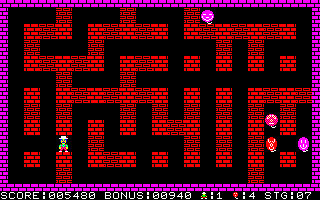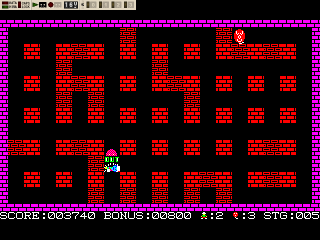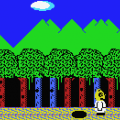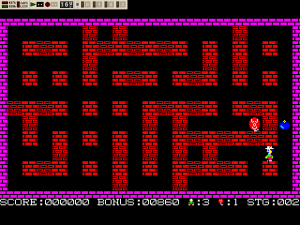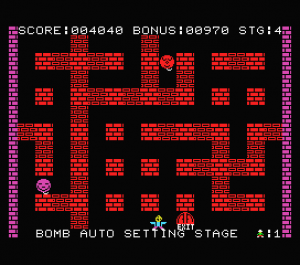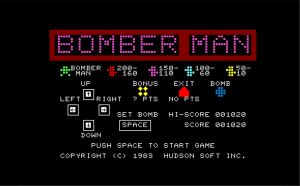- Bomberman Series Introduction / Bomberman (1983)
- 3-D Bomberman
- Bomberman (1985)
- RoboWarrior
- Atomic Punk
- Bomberman (1990)
- Atomic Punk (Arcade)
- Bomberman II
- New Atomic Punk: Global Quest
- Bomberman ’93
- Super Bomberman
- Hi-Ten Bomberman / Hi-Ten Chara Bomb
- Bomberman ’94 / Mega Bomberman
- Super Bomberman 2
- Super Bomberman 3
- Wario Blast: Featuring Bomberman
- Bomberman GB 2
- Bomberman: Panic Bomber
- Super Bomberman 4
- Saturn Bomberman
- Bomberman GB 3
- Bomberman B-Daman
- Super Bomberman 5
- Atomic Bomberman
- Neo Bomberman
- Amazing Bomberman
- Bomberman 64
- Saturn Bomberman Fight!!
- Pocket Bomberman
- Super Bomberman R
- Super Bomberman R Online
Once upon a time, Bomberman was a pretty big deal in the world of video games. As one of the biggest names in console multiplayer, games in the franchise were oftentimes the go-to picks for college dorms and friendly gatherings, allowing anywhere from two to ten people to duke it out. After the 90s, it didn’t take long for Bomberman to fall out of prominence, thanks to factors like Hudson Soft’s financial struggles and their resulting purchase by Konami, leading to less frequent releases that were scattershot in their goals, much like what Konami ended up doing with the Frogger license.
One could also say Bomberman’s greatest strength ended up as a source of weakness: as a game that’s easy to learn but challenging to master, some people feel the franchise peaked with earlier entries like Saturn Bomberman and later entries tried to add too many ingredients to a perfect recipe. There’s also a potential divide between what people seek from Bomberman – many see it as purely a multiplayer experience, whereas some may prefer the entries that go all-in on single player content, such as Bomberman Hero.
Still, Bomberman managed to get dozens upon dozens of releases throughout its long history and the series isn’t done for yet, with a port of Super Bomberman R Online to non-Stadia platforms in 2021 being its most recent entry. The franchise is fascinating and diverse, covering just about every genre there is, from the standard maze action to platformers to sports titles, and there are even several mini-game compilations and a strategy RPG as well!
The fundamentals of Bomberman are straightforward yet masterful in their simplicity. Your single method of attack involves placing down a bomb and waiting for it to explode in a plus-shaped pattern. These explosions usually span one or two squares to start, but once you accumulate some firepower and bomb quantity power-ups, it’s easy to engulf entire rows and columns in flames. You need to exercise caution around your bombs though, since the explosions can kill you as well and a poorly placed bomb can trap you against a wall. Games of Bomberman typically take place in square or rectangular mazes, containing both hard blocks that can’t be destroyed and soft blocks that can be destroyed to clear space or find power-ups. The strategy of the series comes down to knowing the timing of your bomb explosions and where to position them in order to maximize how efficiently you can clear out blocks while avoiding danger, and the environments are big enough to allow for offensive and defensive play. It works well enough against enemy AI, but the game becomes entirely different when played against another human, since trying to predict their next move becomes far more interesting and dynamic knowing that one mistake equals death for an unprepared player.
When playing the single player modes, your goal is usually to complete a number of stages by defeating every enemy and making your way to the exit. As you progress, each world changes the general environment and introduces different gimmicks and stage hazards that mix up the way you play. Enemies become more diverse as well, and can do things like shoot projectiles, move through blocks, or even eat your bombs to prevent them from going off.Power-ups can be found inside soft blocks to make things more manageable and they’re retained between levels should you manage to keep on surviving. Every world is capped off with a boss fight that you’ll have to analyze and learn how to dodge while finding opportunities to hit them with your bombs. This formula gets shaken up significantly whenever Bomberman goes fully 3D or dives into spin-off territory, and there are certainly intricacies unique to each entry, but this is otherwise the template for much of the franchise’s output.
The multiplayer Bomberman experience is all about frantic action and customization that can be enjoyed with other people or with CPU opponents. Players are pitted against one another in a test of reflexes and wits as they aim to accumulate power-ups and be the last one standing. Most of the power-ups from the single player modes show up and players are given a bevy of options to play with, such as different arenas, multiple playable characters, team battle options, and alternate objectives beyond the standard deathmatch. Later entries pile on some additional mechanics too, such as allowing eliminated players to get back in the game if they can take out an opponent from the sidelines. Multitaps for older consoles are still sought after for the purpose of playing Bomberman, which is a testament to the enduring legacy and quality of the multiplayer experience.
For most people, Bomberman began with the Famicom entry in 1985 (which didn’t leave Japan until 1989), but there were actually two games that preceded it. Originally created by Hudson Soft in 1980 as a tech demo for their BASIC compiler, Bomber Man (or Bakudan Otoko) was only given a limited release in 1983 and 1984 on contemporary Japanese computers at the time, contributing to its obscurity elsewhere. European countries would end up getting the game under the title of Eric and the Floaters on the MSX and ZX Spectrum in 1984, with the name change supposedly due to a desire to avoid any potential associations with terrorism. The name change isn’t quite as ill-fitting as it may sound- Bomberman didn’t yet have his iconic robot design. He first appeared as just a guy with a hat and overalls, so giving him a normal name made enough sense. The game was programmed by two Hudson Soft employees, Toshiyuki Sasagawa and Y. Tanaka, and while neither of them would go on to be long-term Hudson Soft regulars, their contributions here were essential in establishing the groundwork for the franchise.
Bakudan Otoko is an endless game where your goal is to eliminate the living balloons (these would go on to be called “Balloms” in future games) that populate each stage. It’s possible to find an exit instead of killing every enemy, but doing so in this particular entry just resets the current level and doesn’t actually advance you to the next stage. There aren’t any power-ups here and there’s only a single kind of environment (albeit one that has a randomized arrangement of blocks each time), so all you’ve got is the ability to place up to five bombs at a time with a blast radius of two squares each. Bomberman moves half a tile at a time, something unique to this entry and the next, which ends up making movement feel somewhat slow and difficult to do, especially when turning corners as you’re being chased.
This strange kind of movement does allow for an interesting mechanic though – by placing bombs in between two tiles, it’s possible to blow up half of a soft block rather than the entire thing. Doing this allows a second bomb’s explosion to pierce through the remaining half, hitting anything that may be on the other side. Half-broken walls can’t be moved through either, making them both an ideal place to protect yourself and a perfect spot to set up an attack.
There’s only one type of enemy to deal with, but they’re more nuanced than you might expect. The balloons move unpredictably around each level in their initial passive state. They won’t go after Bomberman until they turn red, which makes them far faster until they eventually calm back down. In this particular entry, bombs can be passed through, so you can’t use them to block pursuers, requiring you to monitor the location of each enemy at all times.
While it may be tempting to hang back and hide until your foes become passive, you’re rewarded for taking the initiative in multiple ways. Each balloon you manage to destroy will award you with points, but defeating red balloons will give you up to 200 points, whereas waiting until your foe is at their weakest may give you as few as ten points. There’s incentive to clear each stage as quickly as possible, since doing so you grants you additional points. You can also find treasures hidden in the soft blocks, which contribute to your score as well. Scoring is purely for self-satisfaction, since there’s no way to get extra lives and there’s no high score table to record your best attempts either.
When playing on the NEC PC-88 series of computers, everything is visually simplistic but rather colorful and the sprites are detailed and big enough to stand out amongst the action. There’s no music, only sound effects for movement, explosions, and losing a life, which is something that would remain true with every version of the game. This version moves exceptionally fast compared to the others, making it difficult to outrun red balloons without using a wall to break their line of sight.
On the NEC PC-6000 line of computers, the game fares quite well without losing much in the transition. The design of Bomberman has changed to one that’s mostly red with purple hair, and there’s now an extra screen that explains the game when you first begin. Starting and ending the game is also accompanied by a voice sample, which is a neat novelty. The general pace is noticeably slower than on the PC-88, but thankfully not so slow as to ruin the gameplay. The only real knock against this version is that the balloons are always red and only use different expressions to indicate a change in state, making it harder to read their movements.
The version available to the Sharp MZ-700/2000 lines is perhaps the most interesting one, simply because of how much abstraction it has going on. Instead of Bomberman and balloons, every character is represented by an arrangement of squares that vaguely resemble a person, and it’s hard to say what the treasure is even supposed to be. Despite the visual downgrades, the color changing mechanic for the enemies is preserved, the game moves quickly without being overwhelming, and the controls feel among the tightest of the bunch, making it an impressively solid port.
The Sharp X1 version is mostly similar to the PC-88 version with a few additional flourishes. The intro screen now shows Bomberman running away from the balloons and there are also some extra options, such as the ability to enable or disable sound effects. Whenever a stage loads, you now get to watch the individual blocks appear and form the maze, which is pretty neat, but does slow things down a bit since you have to watch it every time. The action itself is unfortunately much slower, making this version pretty tedious to try and actually play.
The Fujitsu FM-7 port is the weakest of the bunch. Everything is much smaller and zoomed out, and the title of the game is displayed constantly at the top and takes up much of the screen. Bomberman now moves constantly and pressing one of the four movement keys makes him face a different direction. This makes precise actions far less reliable, which would normally be a bigger problem if the enemies weren’t also compromised. The balloons (now called “Aliens”) come off as far less competent, pursuing you less frequently and oftentimes starting the round stuck in the corner for several seconds. Things slow to an absolute crawl when even one bomb is placed down and trying to play for prolonged periods simply feels dreadful. The only real positive change in this version is that you get five lives instead of three.
The MSX and ZX Spectrum versions are similarly robust, offering a strong balance of visuals and speed while also introducing a new addition to the gameplay. The ZX Spectrum version is a bit less detailed than the MSX version, with the most notable example being that the balloons are missing faces in the ZX Spectrum version of Eric and the Floaters. Exclusive to these versions are “Bomb Auto Setting” stages that show up occasionally from stage four onwards. During these stages, Bomberman will automatically place a bomb whenever he takes a step. This is as catastrophic as it sounds, since the bombs will set off a chain reaction that’s very difficult to escape. It’s an interesting idea, but it’s more frustrating than anything, since flawlessly planning out your path and hoping the stage layout accommodates said plan is required to avoid a swift death. This idea returns later on in the series as one of the potential consequences of picking up the Skull item.
Thanks to the efforts of the website Gaming Alexandria, a version of Bakudan Otoko for the Hitachi Mark 5 has been preserved. It’s mostly similar to the PC-88 version, but with a few improvements. For starters, the title screen is completely different compared to any other version, opting to sort its information vertically instead of horizontally. Most notably, this is the only version of the game where exits actually bring you to the next stage as you’d expect, making them worth seeking out. This version is reasonably paced and even increases the amount of enemies onscreen at a slightly slower rate (stage five will only have three enemies instead of four like in the PC-88 version), making it one of the best versions overall.
Bakudan Otoko is effectively outclassed by every installment afterwards, but it’s still worthy of recognition for how much of the essence of Bomberman it manages to establish. It may be missing the personality, the variety, and the multiplayer, but the action here paved the way for the Famicom game to become the smash hit that it did. Before that though, Hudson Soft would go on to try one more ambitious, albeit ill-advised, experiment with Bomberman in 1984.







